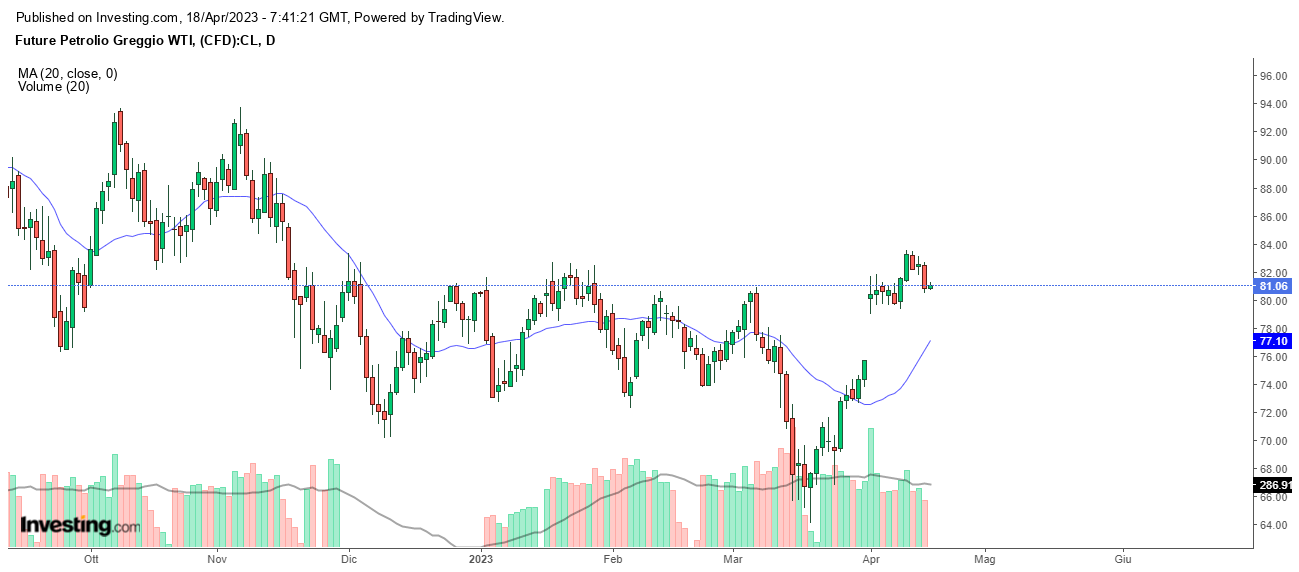Are Rumors About Oil Production Cuts Just Talk?
LCO
-1.83%
Add to/Remove from Watchlist
Add to Watchlist
Add Position
Position added successfully to:
Please name your holdings portfolio
Type:
BUY
SELL
Date:
Amount:
Price
Point Value:
Leverage:
1:1
1:10
1:25
1:50
1:100
1:200
1:400
1:500
1:1000
Commission:
Create New Watchlist
Create
Create a new holdings portfolio
Add
Create
+ Add another position
Close
CL
-1.95%
Add to/Remove from Watchlist
Add to Watchlist
Add Position
Position added successfully to:
Please name your holdings portfolio
Type:
BUY
SELL
Date:
Amount:
Price
Point Value:
Leverage:
1:1
1:10
1:25
1:50
1:100
1:200
1:400
1:500
1:1000
Commission:
Create New Watchlist
Create
Create a new holdings portfolio
Add
Create
+ Add another position
Close
2222
+4.68%
Add to/Remove from Watchlist
Add to Watchlist
Add Position
Position added successfully to:
Please name your holdings portfolio
Type:
BUY
SELL
Date:
Amount:
Price
Point Value:
Leverage:
1:1
1:10
1:25
1:50
1:100
1:200
1:400
1:500
1:1000
Commission:
Create New Watchlist
Create
Create a new holdings portfolio
Add
Create
+ Add another position
Close
Oil prices have surged above $80 per barrel for both Brent and WTI futures, marking a year-to-date high.
Traders are monitoring demand and a report indicating a further reduction in crude inventories at a key US storage hub. While OPEC’s decision to cut production has lowered oil levels in the US, China’s demand is expected to remain strong, thereby supporting prices.
However, the ongoing economic crisis and inflationary pressures in major economies may force central banks to raise interest rates, leading to inevitable repercussions on oil demand. When interest rates rise, economic growth tends to slow down, leading to weaker global oil demand as loans and investments become more expensive.
The Fed can influence oil prices by raising interest rates, which can curtail the upward trajectory of black gold. A sustained increase in rates could bring about stability or even a decline in oil prices. Consequently, the International Monetary Fund has cut its 2023 global growth forecast, and the US Energy (NASDAQ:USEG) Information Administration has lowered its estimates for 2023 growth by 40,000 bpd.
While limited supply may support oil prices, loose conditions created by a more aggressive Fed could cause prices to fall. Additionally, the implementation of production cuts by OPEC remains questionable, as the organization has few regulations. I
n the past, announcements of production cuts have not been fully implemented, and with current prices, there is an incentive to produce more oil and generate greater revenue, potentially undermining the cuts.
In summary, while tight supply and strong demand from China may support oil prices in the short term, the potential for central banks to raise interest rates and uncertainties surrounding OPEC’s production cuts could weigh on prices in the long run. WTI Daily Chart
WTI Daily Chart
Latest reports indicate that Saudi Aramco (TADAWUL:2222) will maintain its oil supplies to Asian refineries, despite OPEC+’s plan to cut production by 1.16 million barrels per day from May through the end of the year.
The UAE’s state-owned Abu Dhabi National Oil Company has also told Asian buyers it will supply them with full contract volumes in June.
From the technical analysis standpoint, oil prices are trading strongly above the fast moving averages but with declining volumes, which makes me suspect that this rapid price rally may be set to end soon.
According to my model, oil should trade at $75 in the next quarter.
***
Author’s note:





